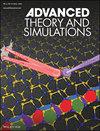WSeTe单层膜上Pd修饰增强NH₃和NO₂传感的DFT研究
IF 2.9
4区 工程技术
Q1 MULTIDISCIPLINARY SCIENCES
引用次数: 0
摘要
这项研究使用第一性原理计算来研究钯(Pd)装饰单层WSeTe (Pd‐WSeTe)作为NH₃和NO₂的高性能气体传感器的潜力。我们量化了Pd放置(SeWTe‐TH、SeWTe‐TSe、SeWTe‐TW、TeWSe‐TH、TeWSe‐TTe和TeWSe‐TW)对WSeTe电子特性的影响,重点关注带隙的变化(ΔEg)。Pd修饰显著地改变了带隙,与原始的WSeTe (1.335 eV)相比,SeWTe‐TH的带隙大幅降低(0.115 eV)。SeWTe - TH的ΔEg大幅减少表明传感器响应的潜在增强。此外,SeWTe‐TSe对目标气体NH₃和NO₂表现出最强的结合能力。SeWTe‐TSe表现出−1.693 eV (NO₂)和−1.517 eV (NH₃)的吸附能,表明其增强的灵敏度和出色的NO₂传感能力。这些结果表明,Pd修饰大大提高了气感性能,特别是沿着SeWTe‐TSe (NO₂)。这使得Pd - WSeTe Janus单层成为一种高灵敏度和选择性的气体传感器,可用于多种任务,如呼吸分析,泄漏检测和环境监测。本文章由计算机程序翻译,如有差异,请以英文原文为准。
Enhanced NH₃ and NO₂ Sensing via Pd Decoration on WSeTe Janus Monolayers: A DFT Investigation
This study uses first‐principles calculation to investigate the potential of palladium (Pd)‐decorated single‐layer WSeTe (Pd‐WSeTe) as high‐performance gas sensors for NH₃ and NO₂. The impact of Pd placement (SeWTe‐TH , SeWTe‐TSe , SeWTe‐TW , TeWSe‐TH , TeWSe‐TTe , and TeWSe‐TW ) is quantified on WSeTe's electronic properties, focusing on the changes in bandgap (ΔEg). Pd decoration significantly alters the bandgap, with SeWTe‐TH exhibiting a drastic reduction (0.115 eV) compared to pristine WSeTe (1.335 eV). This substantial ΔEg reduction in SeWTe‐TH suggests a potential enhancement in sensor response. Furthermore, SeWTe‐TSe displays the strongest binding capacity for targeted gases NH₃ and NO₂. SeWTe‐TSe exhibits adsorption energy of −1.693 eV (NO₂) and −1.517 eV (NH₃), indicating its enhanced sensitivity and exceptional NO₂ sensing capability. These results show that the performance of gas sensing is much improved by Pd decoration, especially along SeWTe‐TSe (NO₂). This makes the Pd‐WSeTe Janus monolayer a highly sensitive and selective gas sensor that may be used for several tasks, such as breath analysis, leak detection, and environmental monitoring.
求助全文
通过发布文献求助,成功后即可免费获取论文全文。
去求助
来源期刊

Advanced Theory and Simulations
Multidisciplinary-Multidisciplinary
CiteScore
5.50
自引率
3.00%
发文量
221
期刊介绍:
Advanced Theory and Simulations is an interdisciplinary, international, English-language journal that publishes high-quality scientific results focusing on the development and application of theoretical methods, modeling and simulation approaches in all natural science and medicine areas, including:
materials, chemistry, condensed matter physics
engineering, energy
life science, biology, medicine
atmospheric/environmental science, climate science
planetary science, astronomy, cosmology
method development, numerical methods, statistics
 求助内容:
求助内容: 应助结果提醒方式:
应助结果提醒方式:


